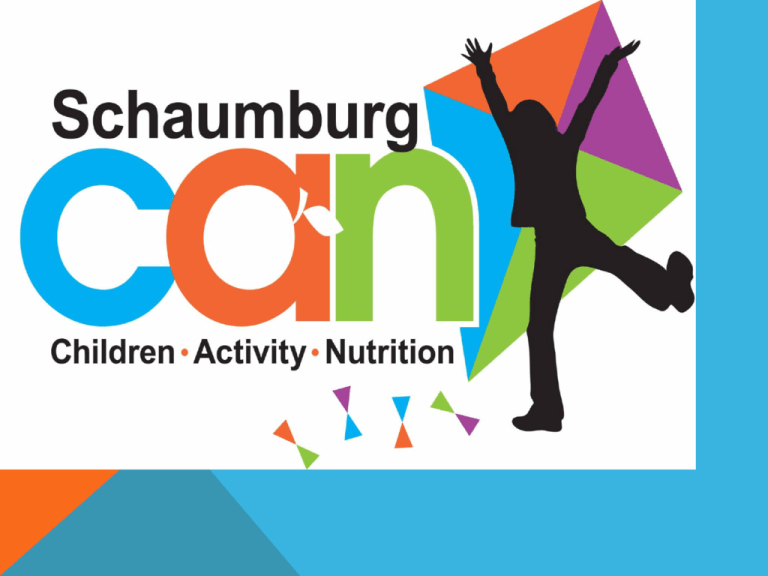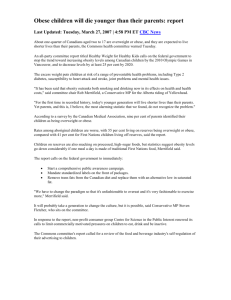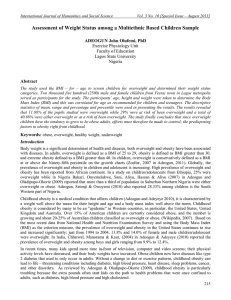Healthy Communities Presentation
advertisement

BACKGROUND • In 2008, YMCA of the USA received funding from the Robert Wood Johnson Foundation to launch the community-based “Pioneering Healthier Communities” policy change initiative. • Six states and 32 communities • Campanelli YMCA THE AIM OF THIS WORK To address the childhood obesity epidemic through policy, systems and environmental (PSE) change efforts that promote and support healthy lifestyles. SCHAUMBURG PIONEERING HEALTHY COMMUNITIES TEAM Alexian Brothers Hospital: Debbie Schmidt and Marcy Traxler District 54: Terri McHugh and Kristie DiVerde YMCA: Dave Burisek Schaumburg Park District: Vince Kennedy Hoffman Estates Park District: Mike Kies Village of Schaumburg: Matt Frank and Mary Passaglia Schaumburg Township Council of PTAs: Lori Filby MISSION Align the community around opportunities that build a foundation of healthy activity and nutrition for our children. VISION Families making healthy choices. FACTS ABOUT CHILDHOOD OBESITY RISING RATES In the past 30 years the rate of obesity in children ages 6 to 11 has tripled. Today, nearly 25 million children are overweight or obese. CHILDHOOD OBESITY RATE IN ILLINOIS Illinois has the 10th highest rate of childhood (ages 10-17) obesity in the nation. 1 in 3 Illinois children are overweight or obese according to the Trust for America’s Health-Advocacy Organization. IMAGINE THIS Some experts believe that if obesity among children continues to increase, our current generation of children will become the first in American history to live shorter lives than their parents. FAILING FOOD • The average teen eats fast food twice a week. • Kids have easy access to high fat, high calorie and low nutrition foods. • School fundraising relies upon food sales: fun foods, ice cream day, hot lunch, tasty treats, pizza day, nacho day, etc. • Food is used as a reward at home and school. • “Super-size me” advertising is everywhere. INACTIVITY • All children don’t have daily physical education. • Children spend on average four to five hours per day watching TV, playing video games or using the computer. • One in four children don’t participate in physical activities during their free time. WHAT IS BMI? • A measure of weight in relation to height • Used to estimate percentage of body fat • Used to screen for overweight kids • BMI does not measure bone, fat or muscle. • Some children with a normal BMI may have an unhealthy body fat level. Other children with a high BMI may have a healthy amount of body fat. If we rely solely on the BMI, some children who need intervention may fall through the cracks. Source: USDA/ARS Children's Nutrition Research Center at Baylor College of Medicine BMI NUMBERS Obese is defined as a BMI at or above the 95th percentile. Overweight is defined as a BMI at or above the 85th percentile. An overweight child has a 70% risk of being an overweight adult. x ys 2010 ys 2012 ys 2015 s 2010 s 2012 s 2015 PERCENT OF DISTRICT 54 KINDERGARTNERS WHO ARE OVERWEIGHT OR OBESE Overweight (85th percentile) Obese (95th percentile) 28% 11% 27% 15% 24% 12% 30% 25% 20% 27% 14% 27% 14% 24% 28% 11% 26% Boys 2010 Boys 2015 Girls 2010 27% Girls 2015 28% 15% 14% 10% 11% 15% 12% 5% 0% Overweight (85th percentile) Obese (95th percentile) PERCENT OF DISTRICT 54 SIXTH-GRADERS WHO ARE OVERWEIGHT OR OBESE Boys 2010 45% 40% Boys 2015 42% 35% 39% 36% Girls 2010 35% 30% 25% Girls 2015 23% 20% 21% 15% 18% 16% 10% 5% 0% Overweight (85th percentile) Obese (95th percentile) THE HUMAN COST OF OBESITY • • • • • • • • • • Increased risk of heart disease High blood pressure Type 2 Diabetes Breathing problems Trouble sleeping Bone and joint problems Low self esteem Depression and anxiety Risk of obsessive compulsive disorder A lifetime of health problems WHY SCHOOL WELLNESS? • Schools have a unique opportunity to address wellness. • Wellness is a part of a school’s fundamental mission. • Schools that address wellness show gains in learning. WHAT SCHOOLS CAN DO • Improve food available at school • Increase physical activity • Teach good nutrition and healthy living • Encourage staff wellness • Engage parents PROJECTS/OBJECTIVES • Healthier PTA Hot Lunch program • Increase before, during and after school physical activities for students across the community • Increase participation in the Safe Routes to School program • Continue to build relationships and network with community partners to enhance the program • Review and revise policies as appropriate changes occur ASSESSMENT – HOW WILL WE KNOW IF STUDENTS AND COMMUNITY ARE HEALTHIER? • PTA hot lunch orders – look for increase of healthy food choices • School, YMCA and park district data – look for access to adequate opportunities for physical activity before, during and after school • Village of Schaumburg data – look for access to and use of attractive and safe routes for physical activity • Policy change data – look for changes that influence people to live healthier lives. • Program data – look for any new or improved healthier community programs CHALLENGES FOR DISTRICT 54 PTA • Promote healthier eating through the hot lunch program. • Think “outside of the box” for fundraising. • Lead children by setting an example of better nutrition. • Help fight the epidemic of childhood obesity. FEEDBACK • Rubric • Questions • Suggestions • 1-2-3 Worksheet









